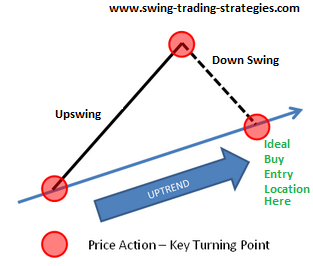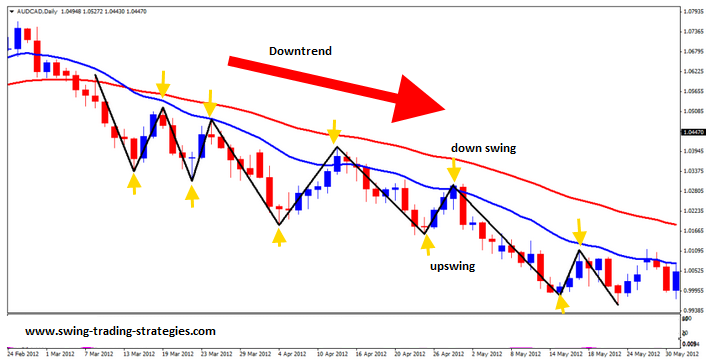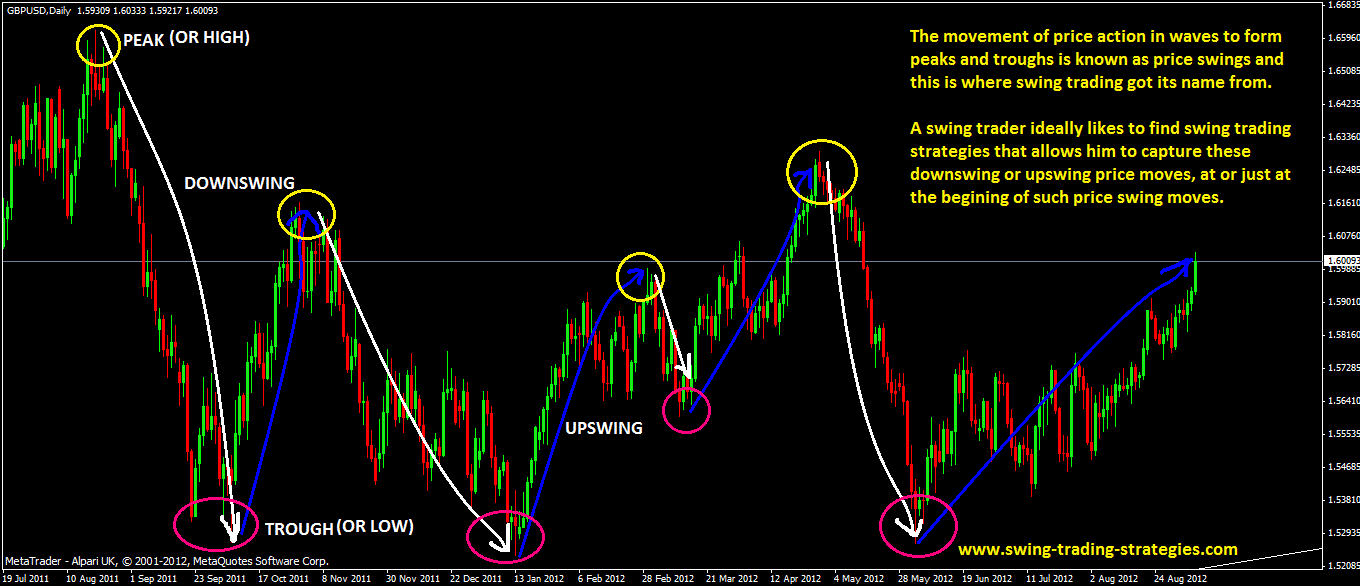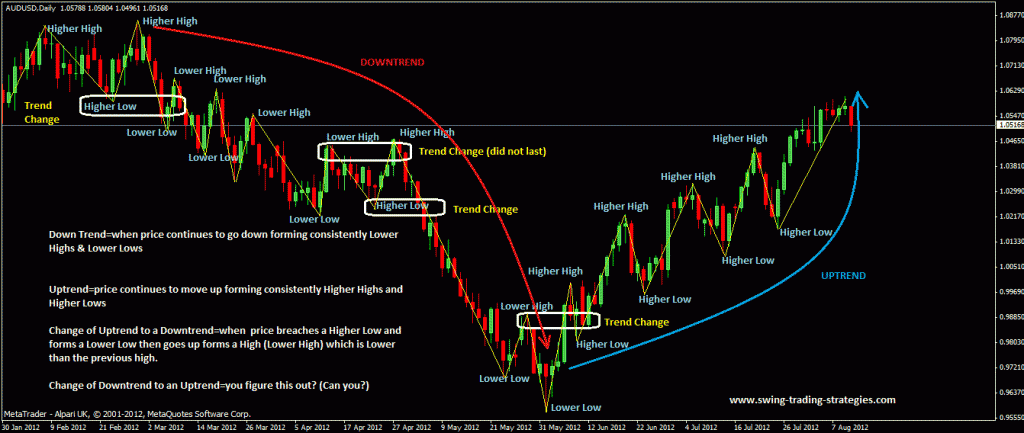Swing Trading, what is it? What Is The difference between swing trading strategies and day trading strategies or scalping or trend trading strategies?
In here your questions will be answered.
But first…
Wikipedia describes swing trading as a speculative trading activity in any financial market whereby instruments such as currencies are
bought or sold at or near the end of up or down price swings.
But that being said…if you are swing trading dummy:
- would you have a clue of what price swings are?
- would you have a clue of what is an upswing or downswing?
- do you know what is a price rally or pullback? Do you know what they mean?
I bet you don’t (or maybe you’d know little).
So lets get into more detail, shall we? This is your introduction to swing trading.
WHAT IS SWING TRADING ? WHAT ARE SWING TRADING STRATEGIES?
The forex market (or any other market) never stays stagnant, it moves. Its like when you inhale and exhale, how you see your tummy grow when you breathe in and tummy grows smaller when your breathe out. It a similar fashion, the forex market breathes and cycles and this is represented by up and down price movements you see on your forex charts.
- When the market is in an uptrend, prices will be increasing but even while the price is increasing, price will fall back again, then it will continue to rise up going past higher than where it fell from.
- In a similar manner, when the market is a downtrend, prices will be decreasing but there will be times when price will increase and then fall back down to go down further below where it rose from.
These two points above are keys to understanding what swing trading is.
Therefore swing trading strategies are trading strategies that try to capture these “market moves” or “swings” to allow you to become profitable.
WHAT DOES PRICE SWINGS IN AN UPTREND LOOK LIKE ON ON A FOREX CHART?
Well, see below…
Just notice that this forex chart below, the market is in an uptrend and price is rising but during its rising, its also falling back down.
This falling back down is called the “down swing”.
And when price rises up again and forms a peak, that is called the “upswing”.
WHAT DOES PRICE SWINGS IN A DOWNTREND LOOK LIKE ON ON A FOREX CHART?
This is what a downtrend looks like with price upswings and down swings.
SO THE POINT IS…
The movement of price action in waves to form peaks(or tops) and troughs (or bottoms) when market is trending either up or down is know and “price swings“. This is where swing trading got its name from.
Have a look at the AUDUSD price chart below and notice those price swings.
(click to enlarge this chart below if its not clear to you)
In the AUSUSD 4HR chart above notice that:
(1) price moves up and down and as it does so, it is
(2) forming peaks and troughs
(3) therefore from a peak to a trough is a swing-a down swing to be more precise.
(4) so when price moves up after forming a trough to form a peak, that is called an up swing (0r upward swing)
That’s a pretty easy concpet to get.
TRENDS
The next thing that you need to understand in swing trading is the concept of price trends and these include but are not limited to the following:
- what is a trend
- how do trends form or how do you know when a trend is just starting?
- when does a trend end or how do you know a trend has just ended ?
- how to identify a trending market?
Now, lets get into more detail…
WHAT IS A TREND?
This is most simplest definition of what a trend is: A trend is the movement of price up or down or sideways over time.
- When price is consistently moving up, forming Higher Highs and Higher Lows, this is called an uptrend.
- When the price is consistently moving down, forming Lower Highs and Lower Lows, this is called a downtrend.
- When Price Price is travelling sideways, it is called sideways trend. In such a sideways trending situation, price is neither going up or down.
These bullent points statements above are the keys to identifying a trending market or a sideways trending market.
(click to enlarge forex chart below if its not clear enough)
HOW DO TRENDS FORM?
In the Daily AUDUSD chart above, notice that when the price was trending down. It has a pattern of conistently forming Lower Highs and Lower Lows but when this pattern is disrupted by a formation of peak higher than the previous peak (Lower High), this can be the first signal that the trend may now changing to an uptrend.
Now remember that, this can also be a false signal as shown in the chart above chart where there was a signal that the downtrend may have changed to an uptrend but that uptrend move did not last.
This could have been the Start of an Uptrend (end of the downtrend) but it did not last as price still continued to swing lower-still in downtrend.
BEST SWING TRADING ENTRY LOCATIONS
 Now for a swing trader, the ideal location of trade entry would be:
Now for a swing trader, the ideal location of trade entry would be:
- on where the prices form peaks and troughs.
- If a swing trader enters a trade on these locations, they would stand to make a lot more profits when the market trends nicely.
- When you enter at these peaks or troughs, your risk is minimized and you have less chance of getting your stop loss hit.
Now, the problems is not all swing trading strategies and techniques would allow a swing trader to get in right at these peaks or troughs for price swings:
- some swing trading strategies can can allow you to enter trades exactly on the peaks or bottoms
- some swing trading strategies will have to wait a while to confirm a peak or bottom is formed before a trader enters into a trade
Whatever your choice may be, nobody can tell you what swing trading forex system to use. Its up to you to decide.
CHECK OUT SWING TRADING STRATEGIES ON THIS WEBSITE
You have lots of swing trading strategies to explore and learn:
- Basic Swing Trading Strategies-Simple Basic Swing Trading Strategies easy to learn and implement for new forex traders
- Simple Swing Trading Strategies-Simple, Also Easy To Learn And Implement
- Complex Swing Trading Strategies-Complex Trading Systems, takes a bit to understand for much more advanced traders
- Advanced Swing Trading Strategies-Much More Advanced Swing Trading Strategies, may involve technical analysis and price action trading, for advanced swing traders.
Some swing traders use swing trading strategies that allow them to enter on price pullbacks.
What are price pullbacks?
Price pullbacks are those price trending movements that go completely opposite to the main trending movement.
Look at the AUDUSD chart above.
In a downward trending scenario, a price pullback happens when price goes up and creates a Lower High and then falls back and continues going lower.
In an upward trending market, a price pullback happens when price goes down and forms a Higher Low (or sometimes this can be also reffered to a Higher Swing Low) and then moves back up again from there.
These are price pullbacks.
One of the keys to successful swing trading is finding the the best moment to enter swing trades right where these pullbacks end or just about to end or when the pullbacks end and the market is starting to trend again.
There are many swing trading strategies in this website. Take your time to explore and see which one appeals to you and test it out.
WHAT IS THE DIFFERENCE BETWEEN SWING TRADING VS DAY TRADING?
Many new forex traders wonder what is the difference between swing trading vs day trading (or day trading vs swing trading).
Well the answer is really simple:
- Swing Trading “generally” is based on swing trading strategies that traders to enter on price swings. For example, if a trend is up, a trader will wait until price comes down again and try to enter anticipating an upswing. The trade will usually last more than a day to weeks.
- But with day trading, any trade that is opened during the day will be closed during the day, it can be for a few minutes to some hours.
- Forex Scalping Trading Is a part of day trading where traders open positions and close it very quickly sometimes in a few minutes looking for very smaller profits.
SWING TRADING vs DAY TRADING? WHICH IS BETTER?
These days, the boundary between swing trading and day trading is not really a line drawn in concrete. And I will tell you why:
- There are so many clowns around-the central bankers, the FED reserve bank chairman, the EU Bank Governor etc…as soon as these clowns open their mouths to speak, they move the market and many times, the market responds like crazy. The market fundamentals are often thrown out door as soon as these guys open their mouths to speak. These guys are the celebrities of the forex market and most financial markets your may be trading right now.
- Also with the current state of the economy globally, (Im writing this as of June 2013) most traders do not want to be caught unaware. When China imports decrease, guess what happens to the countries the china usually buys most products from? They struggle! These kinds of economic news moves the forex market.
So that’s why if you are a swing trader…
YOU NEED TO BE PAYING ATTENTION TO WHAT’S HAPPENING AROUND THE WORLD
The number 1 reason why I say this is because: you’d never want to be caught unaware!
The reason why I say this is based on personal experience. (Ok, I also understand that my experience may not be like yours, or you may never come across what I went through, but regardless, hear me out, ok?).
One day… I remember this day very clearly, it was back in 2008, I just placed a buy trade(or you may also call it a long trade) in EURUSD during the London Trading Market Session based on my swing trading system. The trade immediately went profitable as price rose and then… BAM!
There was a massive red candlestick that formed with such lightning speed that my stop loss was not even triggered.
I struggled to close the trade because price was way down… and moving so fast that it was near impossible to exit that trade-I was locked in a massively losing trade that I could not get out from.
Eventually, the forex broker closed my trade with a massive loss.
I ended up losing around $3,000 on just one trade that day.
This is a real money I’m talking about here.
I never figured out what happened that day, I was just new into forex trading.
Some time later, as I began to study more and learn more, I knew what happened that day: some “clown” opened his mouth to speak and the forex market reacted to that.
(When I say “clown” Im referring to Central/Reserve Bank Chairman/Governors and such type of people who move markets just by opening their mouths to speak!)
That’s why today, I’m 90% of the time a swing trader, but 10% of my time, I day trade.
When I day trade, I look to keep my trade for hours and use those hourly price swing for for my trade entries as well as managing my trade.
Sometimes I enter trades based on day trading entries but if and when price moves favourably then I leave my trades running and these trades then become swing trades where I can leave profitable trades running for days.
When I know that some clowns are going to open their mouths to speak,I stay out of the market even when a swing trade setup is happening on my forex trading chart.
Or when I know that an economic news is coming out, I also wait. The website where I keep track of when these forex news and these clowns are scheduled to speak is forexfactory. Once you go to this website, go to the “calendar” section and it highlights all the news that is expected to be coming out for the week, month etc…
You just need to pay attention to the news items highlighted in red, because these often move the forex markets big time.
If you like this information about “introduction to swing trading” please like it, tweet, or share it, or you can share this page/article on other websites that you may be a member of.
Thanks for popping by.








 Posted in
Posted in